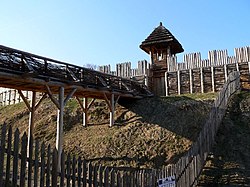Chotěbuz
Chotěbuz ( German Kotzobendz or Kotzobenz, Polish Kocobędz ) is a town in the Moravian- Silesian Region in the Czech Republic. It is located five kilometers north-east of Český Těšín on the Czech- Polish border.
Geography
Chotěbuz located in Beskidenvorland on a knoll between the valleys of the Olsa and Stonávka. West leads the E 75 / E 462 on the Olsa to Poland. In the east, the state road leading 67 of Český Těšín after Karviná and the railway along the Olsa. The station Chotěbuz located in the local situation Podobora. To the north lie the coal mine Dul CSM and the Archeopark Podobora, in the west the dam Těrlicko.
Neighboring towns are Louka and Kempy in the north, and Podobora Marklowice in the northeast, Zpupná Lhota and Boguszowice in the West, Český Těšín the southwest, Mosty and Vyroubaný in the south, Stanislavice the southwest, Pacalůvka in the west and Albrechtice and Pardubice in the northwest.
History
The first written mention of the village was carried out in 1229 as a possession of the Benedictine monastery Orlau. The monastery cultivated in Chotěbuz a paved courtyard. After the dissolution of the monastery in the 15th century the cloister became a separate good and was connected to the 1447 rule Freistadt.
1559 was Teschen Duke Wenceslas III. the estate to his chancellor Wenzel Rudzky of Rudz. This had converted the farm into a fortified castle. Until 1701 Chotěbuz remained the seat of Rudzky of Rudz. After numerous changes of ownership acquired in 1771 Karl Josef Freiherr Trach Březí of the castle. 1802 acquired the Teschen chamber Kotzobendzer the goods.
After the abolition of patrimonial Kotzobendz fancy 1850 a municipality in the district of Teschen. Opened in 1871, the first German school of agriculture in the castle. After the collapse of k.u.k. Monarchy was pulled at the Olsa the border between Poland and Czechoslovakia. Because of the strong Polish population proportion Poland also claimed the Olsagebiet and it came to the Polish- Czechoslovak border war. From 1920, the village belonged to the district Český Těšín. After the Munich Agreement in 1938 Kocobędz connected to Poland and came in the following year after the occupation of Poland to the German Reich. By 1945 Kotzobends belonged to the district of Teschen and came back after the war with Czechoslovakia.
After the dissolution of Okres Český Těšín the place came with the beginning of 1961 to Okres Karviná. In 1975 the annexation to Český Těšín. Since 1998 Chotěbuz again forms a separate municipality.
67 % of the population of Chotěbuz are Czechs, strongest national minority with 27% the Poles.
Community structure
For the community Chotěbuz no districts are reported. To Chotěbuz the local theories include Obora ( Heger houses), Podobora ( animal garden ), and Zpupná Lhota ( Allodial Ellgoth ).
Attractions
- Castle Chotěbuz, in the 16th century arose from the cloister a renaissance festivals of Rudzký of Rudz, which was rebuilt in the early 19th century to a neoclassical palace. 1871 an agricultural school was housed in the castle.
- Watch-tower of the monastery courtyard from the 15th century
- Archeopark Podobora, at the small Olsazufluss Mlynka a castle site was discovered, the evidence of a settlement of the Hallstatt period until the first third of the 11th century
- Bunker chain of the Czechoslovak Walls between Zpupná Lhota and Podobora.









